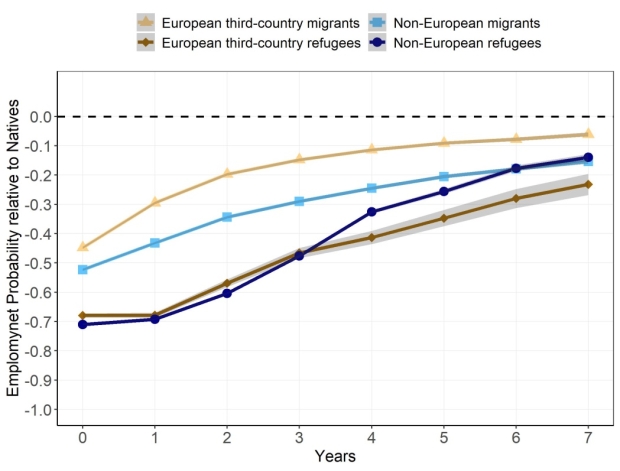Refugees in Austria: Strong labour market integration after several years
21 November 2019
After negotiating initial hurdles, refugee employment rates tend to converge fairly quickly towards those of non-humanitarian migrants and natives.
photo: istock.com/Juanmonino
By Stefan Jestl and Sebastian Leitner
- Highly restricted access to the Austrian labour market and refugee-specific challenges result in low employment rates among asylum seekers in the first years after their arrival in Austria.
- However, two years later the employment rate of refugees starts to converge both with the Austrian-born population and non-humanitarian migrants. After having legal access to the labour market, increased language competence, social integration, training and assistance from the public labour market office helps refugees to find their way into the Austrian labour market.
- This strong performance, however, is not equal among all groups of refugees. Females, the elderly and the highly educated face long-lasting difficulties in their integration into the Austrian labour market.
- Training and supportive measures are needed that focus on these subgroups among refugees, for example targeted language courses, (re-)qualification and more comprehensive consultation programs that help e.g. also women (re)entering the labour market.
Starting in 2014, some European countries including Austria have registered a rising number of asylum applications. In Austria, even though a high share of applications have been rejected, the number of positive decicions ranged between 19,000 and 30,000 per year in the period 2015-2018 (a historically high level). Individuals coming from Afganistan, Syria, Iran and Iraq account for a large part of this group.
Against this background, a major challenge has been to ensure the labour market integration of refugees. In recent years, academic research has investigated the labour market situation of refugees, which focused mainly on North-European countries. A new wiiw study provides a fresh insight into the labour market performance of recently arrived refugees in Austria, and compares it to those of non-humanitarian migrants (students, economic and family migrants) and individuals born in Austrian. To do so, the study makes use of a rich register-based dataset from Statistics Austria.
Catching up after difficult start
To analyse the labour market integration process of refugees, we form four groups of migrants who came to Austria in the period 2009-2018: refugees from non European (non-rich) countries, refugees from European non-EU countries, non-humanitarian migrants from non European (non-rich) countries and non-humanitarian migrants from European non-EU countries. For these four immigrant groups, we estimate the likelihood of them finding a job (full-time, part-time job or self-employed) relative to Austrian-born individuals depending on the time since their arrival. To draw more meaningful conclusions, we consider differences in a set of individual and household characteristics, as well as local labour market indicators. Figure 1 illustrates the employment gaps of the four immigrant groups relative to the Austrian-born population.
Figure 1: Conditional employment gaps for immigrant groups relative to natives
Source: Statistics Austria; own calculations.
Notes: The grey areas indicate the 95% confidence interval. Only refugees and migrants from countries with low and medium GDP p.c. in the age bracket 20-50 at the year of arrival were considered.
In the first year after arrival in Austria, access to the Austrian labour market is strongly restricted for refugees. During the asylum application procedure, their employment options are fairly limited. Moreover, physical and psychological stress as well as a lack of language competence (more the case than for non-humanitarian migrants) can hinder successful labour market integration in the early years in the host country. For non-humanitarian migrants, we identify comparatively higher chances to find a job even in the first years. After a difficult start, however, refugees start a catching-up process not only with respect to the Austrian-born population but also to non-humanitarian migrants. After seven years in Austria, non-European refugees show approximately the same employment probability as non-European migrants. European third-country migrants though reveal the best labour market performance across the total time span. Nevertheless, differences across immigrant groups become smaller, the longer immigrants stay in Austria.
Divergent outcomes suggest need for targeted policies
We find that refugees integrate more into the labour market over time. However, the labour market integration process is not the same for all refugees. Our subgroup analysis suggest that female, elderly and highly educated refugees integrate more slowly into the labour market. The findings for the latter group are somewhat surprising. The reasons are likely to include higher requirements for (host country) language competence for high-skilled jobs, as well as difficulties with the transferability of skills (i.e. in having professional and academic qualifications recognised).
This creates a clear need for labour market policy to focus on the subgroups among refugees, including targeted assistance to improve their labour market integration. For example, more comprehensive consultation programms for female and highly educated refugees would be a first step into the right direction. Furthermore, our results suggest that training programs provided by the Austrian Public Employment Office benefit in particular refugees and improve their job chances.

